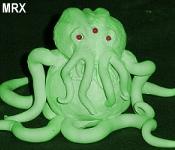I've been making things for as long as I can remember. I made a cardboard box space ship when I was six or seven. I made an electronic intercom system for my bedroom when I was about ten. I made a line of hand painted t-shirts and sneakers when I was about twelve- and on, and on. Most of those items have long since gone to the scrap heap, or disintegrated (I wore some of those t-shirts well into college). But one item from my youthful maker experiments still remains in my possession, and it is in as good of condition as when I made it, back in 1984- when I was twelve.
This is a picture of my first attempt to make a knife. Its shape was loosely inspired by the Klingon D'k tahg, or "warrior's dagger". It was made from a piece of 10 gauge mild steel flat bar that I found laying around in my dad's garage. One night, I just picked it up, clamped it in the work bench vise, and started going at it with a steel file. The corners were clipped with a hack saw. The center was opened up with a drill press, and the majority of the shaping and finishing was done, by hand, with a file. It took a long time. Many many nights were spent out in the garage filing away. Oh, and emery cloth for the polishing. I started working on a cross guard for it, about a year or two after I made the knife, but I soon abandoned that effort.
The blade is 1.75" wide and 9.75" long, and about an eighth of an inch thick. The overall length of the knife is 15.75 inches. Obviously, as a twelve year old, I knew nothing about metalurgy; had no idea about heat treating or tempering. I knew that if you heated a knife blade too much you would ruin the edge, but I didn't really understand why. And I had no idea that mild steel contained too little carbon to ever hold an edge. But hay, it was big and it was wicked looking, and it was all done by me.
The handle was cut from a fallen tree limb I found in the ally behind my parents' house. I have no idea what kind of tree it was, but knowing the region like I do now, it was very possibly silver maple. That neighborhood is littered with them. The tang goes back about a third of the way into the handle. It was affixed by just drilling out a slot in the end of the branch (after whittling off the bark and cutting it to length). Then the slot was jammed over the tang and the branch was hammered home. I always intended to carve a better shape into the handle, but I never did. As with all woodworking projects made at my house during that era, it was stained with used motor oil.
I didn't engrave the MRX initials into the ricasso until a couple years later. But this was also done by hand, using a metal chisel and a hammer.
This is probably the oldest surviving example of any of my projects. Sometimes I look back on some of the things I did as a little kid and I wonder- were my parents even paying attention? Those were different times.
Cthulhu Talisman
-
Fenris49 brings us this Cthulhu talisman sculpted from polymer clay.
22 hours ago






























































